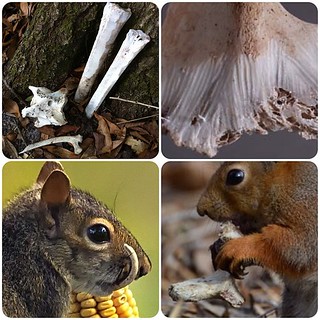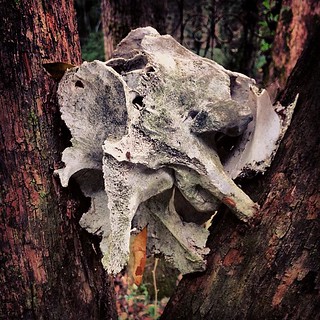
Why do I do this? Most bone collectors have found bones, skulls or even antlers or turtle shells with teeth gnaw marks on them in the outdoors. This is likely caused by squirrels in most cases.
They do this for two reasons: A) As a source of minerals sparse in their normal diet & B) To help keep their teeth from getting too long. Their teeth are always growing & if they get too long it can cause the squirrel to starve or even have the teeth impale them. Eventually resulting in the death of the squirrel. Other animals gnaw on bones for similar reasons as well. Like rabbits. This overgrowth of teeth is called malocclusion.
There was even a giraffe that was photographed recently found gnawing on an impala skull likely for similar reasons.

A well gnawed on deer or wild boar bone.




8 comments:
Hi.
I really like your blog!
How would you go about making a H2O2 bath for bones, having no access to a garden and 4 nosy cats? I mostly find bones that are already pretty much clean, or nothing that putting them on an anthill can't fix, but I'm still worried about disease, and I would like to try whitening bones at some point. Additionally, does it suffice to clean bones I find with a toothbrush and some soap if there's no flesh or other stuff left on them?
Hi refer to these blog posts for help.
If there is still some flesh you need to macerate - http://bone-lust.blogspot.com/2013/04/bonelust-bone-processing-q-what-should.html
If there is no flesh start a peroxide bath - http://bone-lust.blogspot.com/2013/06/whitening-bone-teeth-hydrogen-peroxide.html
My post about sanitary concerns for bone collectors - http://bone-lust.blogspot.com/2013/05/bonelust-bone-processing-q-i-want-to.html
No, soap and toothbrush is not going to sanitize. Need to use peroxide. Good luck!
Thank you :)
I am SO happy to have found your blog! I've been interested in collecting bones for a long time & when a deer died behind my house I waited a few weeks for it to be cleaned naturally and I just went to collect the bones today. I retrieved the skull & it's mandible, the skull still has patches of tissue and fur. You're faq's and articles have been so helpful for me. I just set up the maceration for the skull but I'm not sure if I need to do that for the mandible. It seems fairly clean, no skin or anything left on it, should I just soak it in hydrogen peroxide?
-Camille
Hi Camille, Sorry for my delay in your reply. As long as the bone is free of flesh, fur, ligament, cartilage etc it is ready for a peroxide bath. Good to make sure there's no dirt with. Hope that helps, jana
Other animals gnaw on bones for similar reasons as well. Like rabbits.
I've looked all over the web for information on whether wild rabbits or hares gnaw on bones for their teeth, but this post is one of the only places I've found that suggests it. Do you have a citation for this behavior in rabbits? Or is this something you've observed yourself?
I'd appreciate your input!
-JD
Hi JD... Honestly at this point I can't remember where I read/heard that rabbits/hares gnaw on bone. I wrote this post 2 years ago now. I have seen photos of all kinds of different animals which appeared to be eating/gnawing on bone that don't normally. I guess next to squirrels I highly assumed mice, rats and rabbits have the need to gnaw on bone in the wild to help grind down their ever growing incisors so they do not end up with malocclusion... which would otherwise kill them. I think finding a biologist that researches wild rabbits/hares would be best to ask of this. Good luck, jana
PS - Interesting relate yet vague post I found "Can Rabbits eat Chicken Bones?" - http://www.onlinerabbitcare.com/can-rabbits-eat-chicken-bones/
Thanks for the input. Yeah, I remember as a kid having a ranger explain to me how rodents gnaw on bones to wear down their teeth, but that's all he said: "rodents." I guess I just presumed they all did.
Guess I'm off to find a lagomorphologist ...er, cuniculturist ... or, uhh ... "Rabbit scientist." :)
Post a Comment